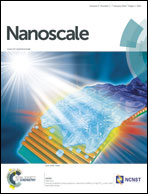The exothermic reaction route of a self-heatable conductive ink for rapid processable printed electronics†
Abstract
We report the exothermic reaction route and new capability of a self-heatable conductive ink (Ag2O and silver 2,2-dimethyloctanoate) in order to achieve both a low sintering temperature and electrical resistivity within a short sintering time for flexible printed electronics and display appliances. Unlike conventional conductive ink, which requires a costly external heating instrument for rapid sintering, self-heatable conductive ink by itself is capable of generating heat as high as 312 °C when its exothermic reaction is triggered at a temperature of 180 °C. This intensive exothermic reaction is found to result from the recursive reaction of the 2,2-dimethyloctanoate anion, which is thermally dissociated from silver 2,2-dimethyloctanoate, with silver oxide microparticles. Through this recursive reaction, a massive number of silver atoms are supplied from silver oxide microparticles, and the nucleation of silver atoms and the fusion of silver nanoparticles become the major source of heat. This exothermic reaction eventually realizes the electrical resistivity of self-heatable conductive ink as low as 27.5 μΩ cm within just 40 s by combining chemical annealing, which makes it suitable for the roll-to-roll printable electronics such as a flexible touch screen panel.


 Please wait while we load your content...
Please wait while we load your content...